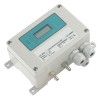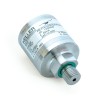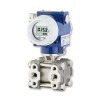Static Line Pressure is the total pressure present at a particular point along a pressurised pipe.
It is often quoted on the specifications for differential pressure sensors as an indicator of the maximum pressure that can be applied to both the high and the low side pressure ports at the same time. This should not be confused with the over-pressure limit which is related to the differential pressure range rather than the static line pressure.
Featured differential pressure measurement products
 Monitoring hot and cold aisle containment in datacenters using a differential pressure transmitter - Low range differential pressure transmitter with a local display was used to maintain precise room pressurization in a mission-critical datacenter environment for improved thermal management.
Monitoring hot and cold aisle containment in datacenters using a differential pressure transmitter - Low range differential pressure transmitter with a local display was used to maintain precise room pressurization in a mission-critical datacenter environment for improved thermal management. 41X High Precision Low Range Pressure Transmitter - High precision pressure transmitter for measuring very low vented gauge reference or differential air pressures. Rangeable 4-20mA or 0-10 volt output.
41X High Precision Low Range Pressure Transmitter - High precision pressure transmitter for measuring very low vented gauge reference or differential air pressures. Rangeable 4-20mA or 0-10 volt output.
Glossary of Pressure Range technical terms
- Bidirectional
- Burst Pressure
- FS – Full Scale
- Gauge Reference Pressure
- Negative Gauge Pressure
- Reference Pressure
- SG – Sealed Gauge
- Vented Gauge
Help from Pressure Range resources
- Measuring vacuum with negative gauge or absolute ranges
- What is the difference between gauge and absolute pressure measurement
- What is the difference between vacuum and absolute pressure
- Measuring negative pressure using a positive differential pressure range
- What is difference between working, burst and over pressure
- What does negative and positive gauge pressure mean









